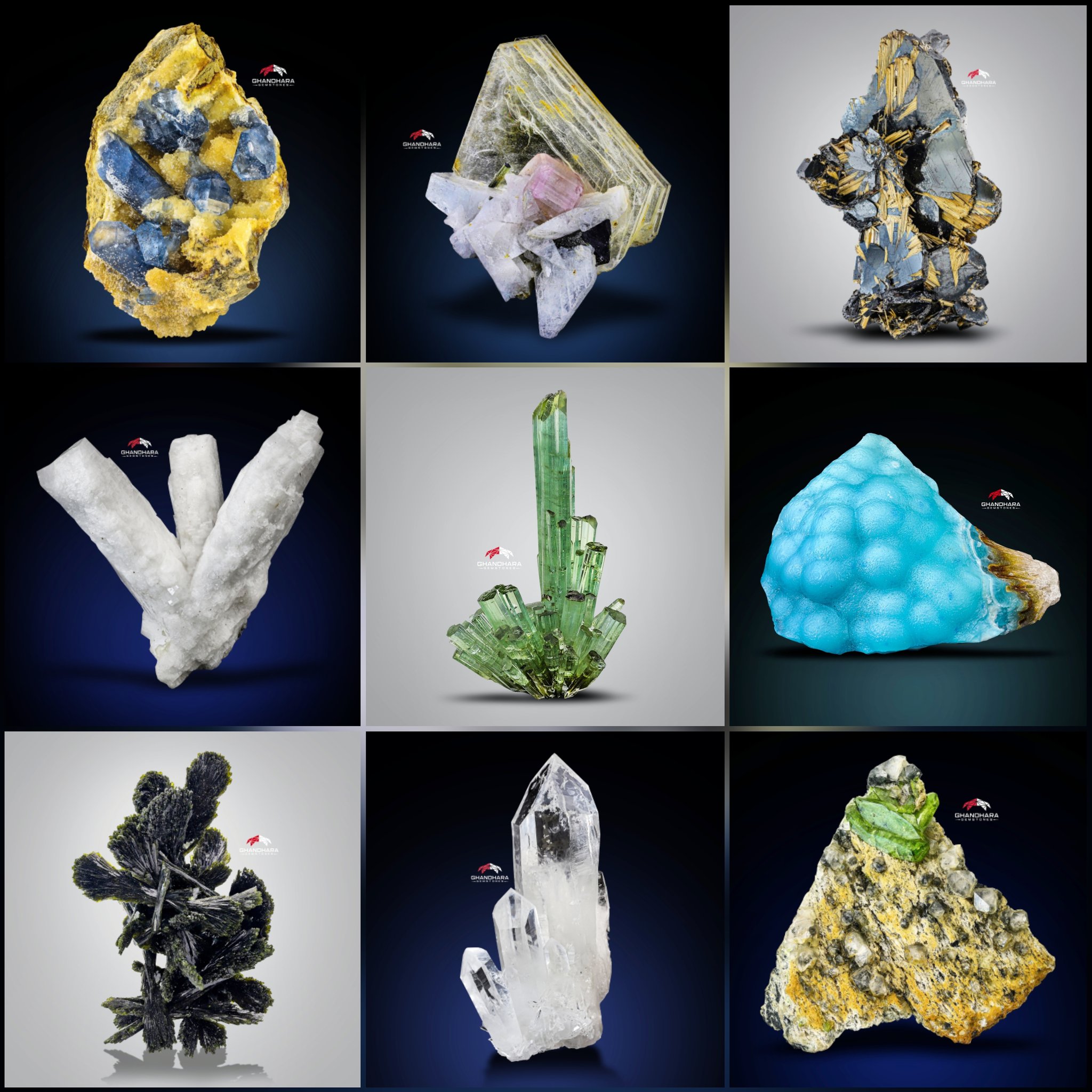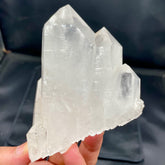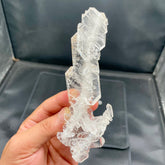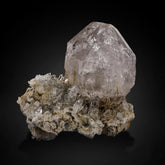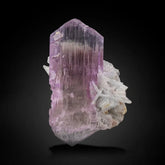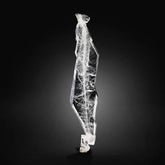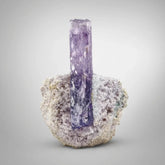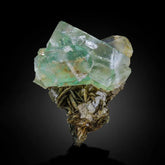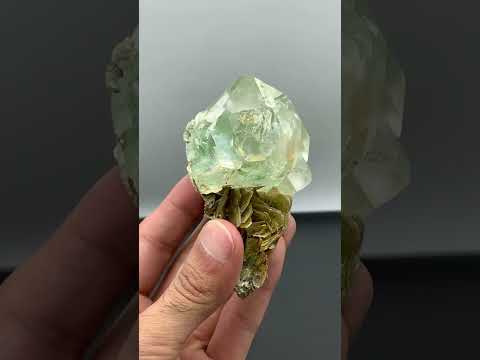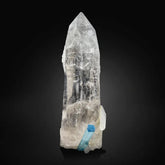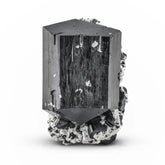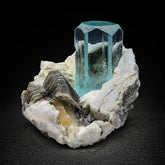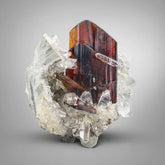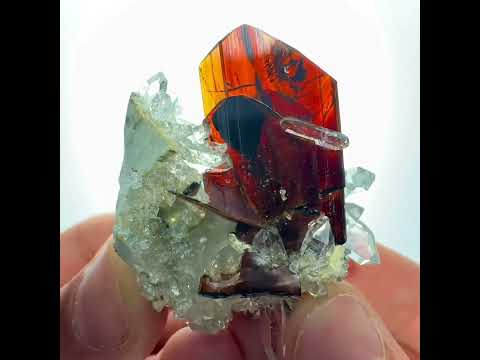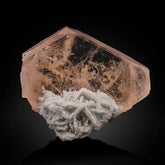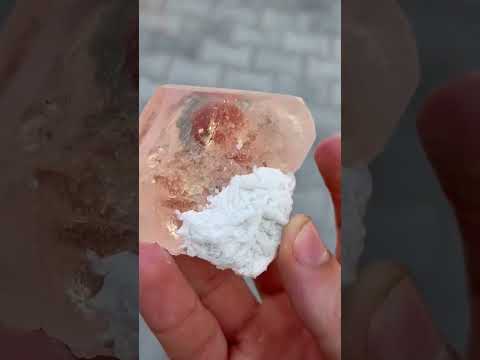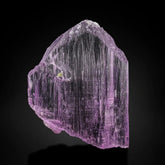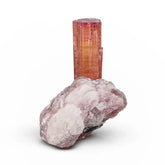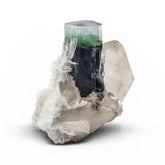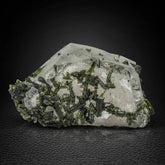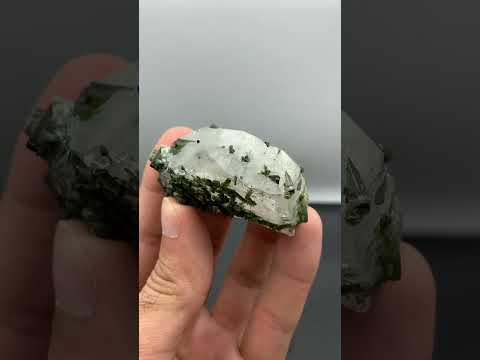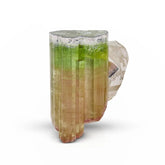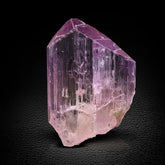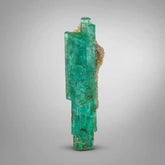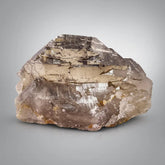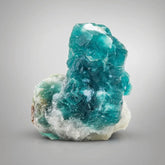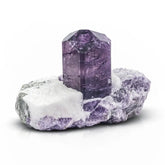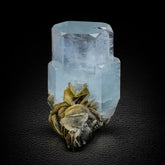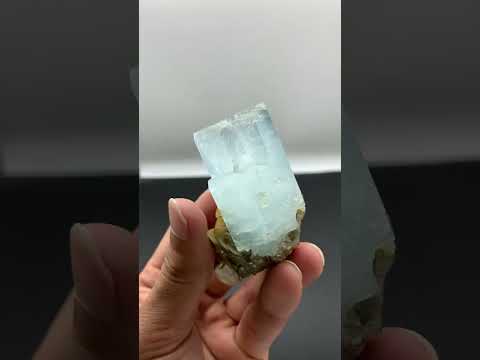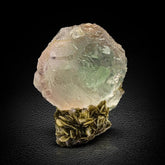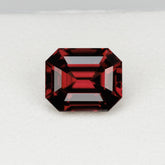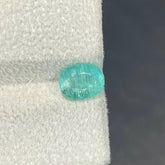Filter
1645 results
30
- 10
- 15
- 20
- 25
- 30
- 50
Date, new to old
- Featured
- Best selling
- Alphabetically, A-Z
- Alphabetically, Z-A
- Price, low to high
- Price, high to low
- Date, old to new
- Date, new to old
Sort
Sort by:
- Featured
- Best selling
- Alphabetically, A-Z
- Alphabetically, Z-A
- Price, low to high
- Price, high to low
- Date, old to new
- Date, new to old
-
Interconnected Faden Quartz Combined Crystals Specimen from Pakistan - White
This Faden Quartz crystal specimen from Pakistan is a stunning example of natural mineral beauty. Mined from the rich geological regions of the Himalayas, this specimen features pristine, transparent crystals with sharp terminations and excellent clarity. The Faden quartz points are well-formed, showcasing the...- $350.00
- $350.00
- Unit price
- / per
-
White
-
Sculptural Of Clear Quartz Crystals Specimen from Pakistan - White
This Clear Quartz crystal specimen from Pakistan is a stunning example of natural mineral beauty. Mined from the rich geological regions of the Himalayas, this specimen features pristine, transparent crystals with sharp terminations and excellent clarity. The quartz points are well-formed, showcasing the hexagonal...- $850.00
- $850.00
- Unit price
- / per
-
White
-
Focal Window Quartz Crystal on Calcite with Luster and Aesthetics from Pakistan - Light-Yellow
This captivating specimen features a striking focal window quartz crystal elegantly perched on a bed of creamy white calcite, showcasing exceptional clarity and form. The quartz exhibits a prominent window termination—an eye-catching geometric facet that adds both intrigue and visual depth. Its sharp, well-defined...- $950.00
- $950.00
- Unit price
- / per
-
Light-Yellow
-
Double Terminated Pink Kunzite Crystal on Cleavelandite Matrix from Afghanistan - pinkish_purple
This stunning specimen features a double-terminated pink Kunzite crystal elegantly nestled on a bed of Cleavelandite matrix, sourced from the renowned mines of Afghanistan. The Kunzite, a vibrant pink variety of spodumene, displays excellent transparency and luster, with both terminations well-formed and sharply defined—an...- $850.00
- $850.00
- Unit price
- / per
-
pinkish_purple
-
Double Terminated Sculptural Of Glassy Faden Quartz Crystal from Pakistan - White
This exquisite Double Terminated Sculptural Glassy Faden Quartz Crystal from Pakistan is a striking natural specimen celebrated for its clarity, unique formation, and aesthetic appeal. Characterized by its distinctive "faden" line a visible white thread-like inclusion running through the length of the crystal this...- $4,200.00
- $4,200.00
- Unit price
- / per
-
White
-
Vivid Purple Free Standing Kunzite Crystal on Albite from Afghanistan - pinkish_purple
This stunning specimen from Afghanistan showcases a vibrant purplish pink Kunzite crystal perched gracefully on a white Albite matrix. The Kunzite crystal, with its elongated and transparent structure, exhibits a delicate pink hue, which intensifies when exposed to light. Its lustrous surface reflects a...- $2,500.00
- $2,500.00
- Unit price
- / per
-
pinkish_purple
-
Vibrant Green Intergrown Fluorite Crystals on Muscovite from Pakistan - LightGreen
This striking specimen features a vivid green fluorite crystal delicately perched atop a shimmering matrix of muscovite. The fluorite displays sharp edges and a pristine translucence, with its geometric octahedral form showcasing a mesmerizing depth of color ranging from light emerald to deeper green...- $750.00
- $750.00
- Unit price
- / per
-
LightGreen
-
Vibrant Blue Aquamarine Crystal on Huge Pointed Terminated Quartz from Pakistan - sky-blue
This stunning specimen features a vibrant blue aquamarine crystal beautifully perched atop a massive, sharply pointed, terminated quartz crystal, sourced from the mineral-rich mountains of Pakistan. The aquamarine displays exceptional clarity and a vivid sky-blue hue, contrasting elegantly with the pristine, glassy quartz below....- $6,500.00
- $6,500.00
- Unit price
- / per
-
sky-blue
-
Double Terminated Black Tourmaline with Albite and Opal Halite from Namibia - Black
This striking specimen from Namibia features a rare double-terminated Black Tourmaline crystal, beautifully complemented by delicate formations of Albite and shimmering Opal Halite. The tourmaline, known for its grounding and protective energies, displays natural terminations at both ends, enhancing its aesthetic and metaphysical appeal....- $1,500.00
- $1,500.00
- Unit price
- / per
-
Black
-
Multi Faced Aquamarine Crystal on Albite with Quartz from Pakistan - LightBlue
Aquamarine nestled within an Quartz and Albite specimen matrix from Pakistan, this natural wonder is a true testament to the beauty that Mother Earth can create. The Aquamarine gem, with its soothing, cool blue hues, is gracefully positioned within the Albite matrix, creating a...-
LightBlue
-
-
Combination of Sharp Saturated Red Brookite Crystal with Quartz from Pakistan - Red
Impressive radiant specimen features blood-red compact Brookite crystal elegantly perched on a bed of pristine Quartz. The Brookite crystal, known for its rare and distinctive color, exhibits a rich and deep red hue, which contrasts beautifully against the translucent white Quartz matrix. This exceptional...- $2,250.00
- $2,250.00
- Unit price
- / per
-
Red
-
Pinkish-Peach Tabular Morganite Crystal with Cleavelandite Matrix from Afghanistan - Peach
This striking specimen features a soft peach morganite crystal beautifully set against a backdrop of vibrant and delicate cleavelandite from Afghanistan. The morganite, with its gentle blush-pink hue, is radiant and exudes a subtle warmth, contrasting elegantly with the cool, beside it. The depth...- $2,500.00
- $2,500.00
- Unit price
- / per
-
Peach
-
Vibrant Pink Double Terminated Kunzite with Excellent Transparency from Afghanistan - pinkish_purple
This vibrant pink double-terminated Kunzite from Afghanistan is a stunning example of the region's exceptional gemstone quality. Exhibiting excellent transparency and a rich, vivid pink hue, this crystal radiates brilliance and charm from every angle. The double terminations enhance its natural aesthetic appeal and...- $3,500.00
- $3,500.00
- Unit price
- / per
-
pinkish_purple
-
Free Standing Rubilite Tourmaline Crystal on Lepidolite from Afghanistan - Pink
This striking specimen features a free-standing rubellite tourmaline crystal perched elegantly on a matrix of shimmering lepidolite, sourced from the renowned mines of Afghanistan. The rubellite, a vivid pink to deep raspberry red variety of tourmaline, rises with impressive clarity and luster, showcasing its...- $2,800.00
- $2,800.00
- Unit price
- / per
-
Pink
-
Bi color Tourmaline Crystal on Smoky Quartzand Albite from Pakistan - Bicolor
A captivating display of nature's artistry, a stunning composition of Bi color Tourmaline on Albite with Smoky Quartz emerges from the depths of Pakistan's mineral-rich landscapes. The deep, enigmatic hues of Tourmaline seamlessly contrast with the pristine beauty of Albite, creating a visually striking...- $4,500.00
- $4,500.00
- Unit price
- / per
-
Bicolor
-
Combination of Tabular Morganite with Mint-Green Tourmaline Crystals from Afghanistan - Green
This exquisite mineral specimen showcases a rare and visually striking combination of tabular morganite and mint-green tourmaline crystals from Afghanistan, a region renowned for producing some of the world's finest pegmatite gemstones. The morganite, characterized by its soft pink hue and flattened, hexagonal crystal...- $850.00
- $850.00
- Unit price
- / per
-
Green
-
Robust Tourmaline Cluster on Albite Matrix with Purple hue from Afghanistan - Black
This striking specimen features a robust cluster of tourmaline crystals perched elegantly on an albite matrix, sourced from the renowned mineral-rich regions of Afghanistan. The tourmaline displays a deep, vibrant purple hue, an uncommon and highly sought-after coloration that adds exceptional visual appeal. The...- $850.00
- $850.00
- Unit price
- / per
-
Black
-
Aggregate of Thick Muscovite Mica Sheets Crystals on Albite from Pakistan - Gray
In this captivating mineral specimen from Pakistan, silver-gray Muscovite Mica elegantly adorn a backdrop of Albite crystals. The Muscovite Mica forms intricate and delicate rosettes, displaying a captivating interplay of light and shadow. Each rosette, with its silver-gray luster, contributes to the overall aesthetic...- $450.00
- $450.00
- Unit price
- / per
-
Gray
-
Double Terminated tri-color Tourmaline on Smoky Quartz from Afghanistan - Bicolor
This exquisite Tri-Color Tourmaline crystal from Afghanistan showcases a stunning natural gradient of colors, transitioning seamlessly from deep pink at the base through vibrant green to a rich blue or clear cap at the termination. Mined from the renowned pegmatite deposits of Afghanistan, this...-
Bicolor
-
-
Pink Kunzite Crystal with Excellent Quality and Color from Afghanistan - pinkish_purple
This exquisite Kunzite crystal from Afghanistan is a true collector's gem, showcasing a delicate pink-to-lilac hue that radiates soft, soothing energy. What makes this piece truly exceptional is the rare association with Microlite and Cleavelandite minerals seldom found together in such harmonious combination. The...- $1,800.00
- $1,800.00
- Unit price
- / per
-
pinkish_purple
-
Double Terminated Dark Green Emerald Crystal with Calcite from Afghanistan - Green
This striking specimen features a double-terminated dark green emerald crystal embedded in a matrix of calcite, originating from the renowned gem-producing regions of Afghanistan. The emerald displays rich, saturated green hues, with both terminations well-formed and sharply defined, showcasing its natural hexagonal crystal structure....- $1,800.00
- $1,800.00
- Unit price
- / per
-
Green
-
Huge Lustrous Smoky Gwindel Quartz with Excellent Transparency from Pakistan - Light-Yellow
This exceptional Gwindel Quartz crystal, hailing from the rugged terrains of Pakistan, stands as a testament to the awe-inspiring beauty of nature's creations. Nestled within its matrix, this geological wonder showcases a rare and captivating phenomenon. Gwindel Quartz, characterized by its twisted, contorted growth,...- $8,500.00
- $8,500.00
- Unit price
- / per
-
Light-Yellow
-
Sculptural Cluster of Double Terminated Faden Quartz Crystals from Pakistan - White
This sculptural cluster of double-terminated Faden Quartz crystals from Pakistan is a striking natural formation, showcasing a delicate and intricate lattice of transparent, elongated quartz points. Each crystal is distinctly double-terminated, meaning it tapers to points at both ends, a rare feature that adds...- $450.00
- $450.00
- Unit price
- / per
-
White
-
Rare Hauyne Sodalite Crystal Aggregate on Calcite from Afghanistan - indicolite
This striking specimen features a rare aggregate of Hauyne and Sodalite crystals nestled on a matrix of white Calcite, sourced from the mineral-rich regions of Afghanistan. The Hauyne crystals exhibit vivid electric blue hues with a translucent to semi-transparent quality, often accented by the...-
indicolite
-
-
Fluorite Crystal on Muscovite with Excellent Transparency from Pakistan - Light-Yellow
Enhance your energy and crystal collection with this genuine Fluorite Crystal on Muscovite, directly sourced from the renowned Nagar Valley, Skardu District, Gilgit Baltistan Province, Pakistan — a world-famous region for premium mineral specimens. ✨ Key Features Specimen Name: Fluorite Crystal on Muscovite Origin: Nagar...-
Light-Yellow
-
-
Free Standing Purple Scapolite Crystal on Calcite Matrix from Afghanistan - Purple
Purple Scapolite crystals on a backdrop of translucent Calcite create a stunning and captivating mineral specimen. The Scapolite, with its rich hue, commands immediate attention, drawing the eye with its intense purple coloration. The Scapolite crystals themselves may vary in size and shape, but...-
Purple
-
-
Tabular Peachy Pink Morganite Crystals on Albite Matrix from Afghanistan - peachy_pink
This stunning specimen features tabular, peachy pink Morganite crystals delicately perched on a contrasting albite matrix, sourced from the renowned pegmatite deposits of Afghanistan. The Morganite crystals display a soft, pastel hue with excellent transparency and luster, their flattened, hexagonal habit highlighting their natural...-
peachy_pink
-
-
Tri Color Tourmaline Crystal with Excellent Colorful Array from Afghanistan - Bicolor
This exquisite Tri-Color Tourmaline crystal from Afghanistan showcases a stunning natural gradient of colors, transitioning seamlessly from deep pink at the base through vibrant green to a rich blue or clear cap at the termination. Mined from the renowned pegmatite deposits of Afghanistan, this...- $2,150.00
- $2,150.00
- Unit price
- / per
-
Bicolor
-
Light Blue Aquamarine Crystal on Muscovite Matrix from Pakistan - LightBlue
This stunning cluster features the typical aqua-blue color of high-quality aquamarine crystals, elegantly nestled among silvery Muscovite blades. Originating from the mineral-rich regions of Pakistan, the aquamarine exhibits exceptional clarity and brilliance, with well-formed hexagonal prismatic crystals that capture and reflect light beautifully. The...- $1,200.00
- $1,200.00
- Unit price
- / per
-
LightBlue
-
Bi color Focal Fluorite Crystal on Muscovite Matrix from Pakistan - Bicolor
This striking specimen features a bi color focal fluorite crystal perched elegantly on a matrix of delicate muscovite from Pakistan. The fluorite displays a captivating blend of colors, often transitioning from a rich or deep greenish core to a softer bluish hue at the...- $1,500.00
- $1,500.00
- Unit price
- / per
-
Bicolor
